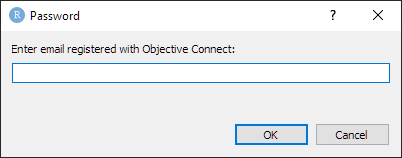How authentication works
The first time you send a request, the API requires your Objective Connect user email address and password to authenticate.
Each successful response from the API includes a token. This token can then be used to authenticate subsequent requests in your session, negating the need to repeatedly supply your email address and password.
The rest of this article details how to manage authentication when
using the objr package.
First request
You will need your Objective Connect user email address and password to make a first request to the API. These can be provided in two ways.
R Environment variables
Add two variables to your .Renviron file to define your
email address and password.
-
Open your
.Renvironfile to edit:usethis::edit_r_environ() -
Add two variables as follows (replacing
XXXwith your credentials):OBJR_USR = "XXX" OBJR_PWD = "XXX" Save and close the
.Renvironfile.-
To check this has worked as expected, first restart your R session then run:
Sys.getenv("OBJR_USR") Sys.getenv("OBJR_PWD")Your credentials should be printed in the console.
Note: It is important not to save your R session workspace on close as your console may contain your Objective Connect credentials.
The benefit of this method is that you can leave this information in
your .Renviron file and objr will
automatically find them here each time you use the package.
Subsequent requests
Each successful API response includes a token that can be used for
subsequent requests. objr functions automatically parse
this token from the API response and store it in your R session’s global
environment.
Where this object exists, objr will automatically use it
to authenticate subsequent requests.
If this object doesn’t exist, objr will resort to using
your username and password, as it did for your first request.
